

[原创] NXP LPC5410x系列32位ARM MCU开发方案
嵌入式技术
描述
NXP公司的LPC5410X系列是基于ARM Cortex-M4F的32位MCU,工作频率高达100MHz.器件集成了104KB SRAM,512KB闪存,3个I2C接口,2个SPI接口,4个USART接口和32位计数器/定时器,以及SCTimer/PWM和12位 4.8MSPS ADC,主要用于嵌入式应用,支持运动,手势控制等.本文介绍了LPC5410x主要特性和优势,框图,以及LPCXpresso54102评估板主要特性,电路图和主要元件布局图.
The LPC5410x are ARM Cortex-M4F based microcontrollers for embedded applications. These devices include an optional ARM Cortex-M0+ coprocessor, 104 KB of on-chip SRAM, 512 KB on-chip flash, five general-purpose timers, one State-Configurable Timer with PWM capabilities (SCTimer/PWM), one RTC/alarm timer, one 24-bit Multi-Rate Timer (MRT), a Windowed Watchdog Timer (WWDT), four USARTs, two SPIs, three Fast-mode plus I2C-bus interfaces with high-speed slave mode, and one 12-bit 4.8 Msamples/sec ADC.
The ARM Cortex-M4 is a 32-bit core that offers system enhancements such as low power consumption, enhanced debug features, and a high level of support block integration. The ARM Cortex-M4 CPU incorporates a 3-stage pipeline, uses a Harvard architecture with separate local instruction and data buses as well as a third bus for peripherals, and includes an internal prefetch unit that supports speculative branching. The ARM Cortex-M4 supports single-cycle digital signal processing and SIMD instructions. The Cortex-M4F is the Cortex-M4 with the inclusion of the 32-bit Floating Point Unit.
The ARM Cortex-M0+ coprocessor is an energy-efficient and easy-to-use 32-bit core which is code- and tool-compatible with the Cortex-M4F core. The Cortex-M0+coprocessor offers up to 100 MHz performance with a simple instruction set and reduced code size
LPC5410x主要特性和优势:
Dual processor cores: ARM Cortex-M4 and ARM Cortex-M0+.The M0+ core runs at the same frequency as the M4 core. Both cores operate up to a maximum frequency of 100 MHz.
ARM Cortex-M4F core (version r0p1):
ARM Cortex-M4 processor, running at a frequency of up to 100 MHz.
Floating Point Unit (FPU) and Memory Protection Unit (MPU).
ARM Cortex-M4 built-in Nested Vectored Interrupt Controller (NVIC).
Non-maskable Interrupt (NMI) input with a selection of sources.
Serial Wire Debug with eight breakpoints and four watch points.
Includes Serial Wire Output for enhanced debug capabilities.
System tick timer.
ARM Cortex-M0+ core (version r0p1):
ARM Cortex-M0+ processor, running at a frequency of up to 100 MHz.
ARM Cortex-M0+ built-in Nested Vectored Interrupt Controller (NVIC).
Non-maskable Interrupt (NMI) input with a selection of sources.
Serial Wire Debug with four breakpoints and two watch points.
System tick timer.
On-chip memory:
Up to 512 KB on-chip flash program memory with flash accelerator and 256 byte page erase and write.
104 KB SRAM for code and data use.
ROM API support:
Flash In-Application Programming (IAP) and In-System Programming (ISP).
Power control API.
Serial interfaces:
Four USART interfaces with synchronous mode and 32 kHz mode for wake-up from Deep-sleep and Power-down modes. The USARTs include a FIFO buffer and share a fractional baud-rate generator.
Two SPI interfaces, each with four slave selects and flexible data configuration.The SPIs include a FIFO buffer. The slave function is able to wake up the device from Deep-sleep and Power-down modes.
Three I2C-bus interfaces supporting fast mode and Fast-mode Plus with data rates of up to 1Mbit/s and with multiple address recognition and monitor mode. Each I2C-bus interface also supports High Speed Mode (3.4 Mbit/s) as a slave. The slave function is able to wake up the device from Deep-sleep and Power-down modes.
Digital peripherals:
DMA controller with 22 channels and 20 programmable triggers, able to access all memories and DMA-capable peripherals.
Up to 50 General-Purpose Input/Output (GPIO) pins. Most GPIOs have configurable pull-up/pull-down resistors, programmable open-drain mode, and input/output inverter.
GPIO registers are located on the AHB for fast access. The DMA supports GPIO ports.
Up to eight GPIOs can be selected as pin interrupts (PINT), triggered by rising,falling or both input edges.
Two GPIO grouped interrupts (GINT) enable an interrupt based on a logical
(AND/OR) combination of input states.
CRC engine.
Timers:
Five 32-bit general purpose timers/counters, with up to 4 capture inputs and 4 compare outputs, PWM mode, and external count input. Specific timer events can be selected to generate DMA requests.
One State Configurable Timer/PWM (SCT) with 6 input and 8 output functions(including capture and match). Inputs and outputs can be routed to/from external pins and internally to/from selected peripherals. Internally, the SCT supports 13 captures/matches, 13 events and 13 states.
32-bit Real-time clock (RTC) with 1 s resolution running in the always-on power domain. A timer in the RTC can be used for wake-up from all low power modes including Deep power-down, with 1 ms resolution. The RTC is clocked by the 32 kHz oscillator.
Multiple-channel multi-rate 24-bit timer (MRT) for repetitive interrupt generation at up to four programmable, fixed rates.
Windowed Watchdog Timer (WWDT).
Ultra-low power Micro-tick Timer, running from the Watchdog oscillator, that can be used to wake up the device from low power modes.
Repetitive Interrupt Timer (RIT) for debug time-stamping and general-purpose use.
Analog peripheral: 12-bit, 12-channel, Analog-to-Digital Converter (ADC) supporting 4.8 Msamples/s. The ADC supports two independent conversion sequences.
Clock generation:
12 MHz internal RC oscillator.
External clock input for clock frequencies of up to 24 MHz.
Internal low-power, watchdog oscillator with a nominal frequency of 500 kHz (WDOSC).
32 kHz low-power RTC oscillator.
System PLL allows CPU operation up to the maximum CPU rate. May be run from the internal RC oscillator, the external clock input CLKIN, or the RTC oscillator.
Clock output function for monitoring internal clocks.
Frequency measurement unit for measuring the frequency of any on-chip or
off-chip clock signal.
Power-saving modes and wake-up:
Integrated PMU (Power Management Unit) to minimize power consumption.
Reduced power modes: Sleep, Deep-sleep, Power-down, and Deep power-down.
Wake-up from Deep-sleep and Power-down modes via activity on the USART, SPI,and I2C peripherals.
Wake-up from Sleep, Deep-sleep, Power-down, and Deep power-down modes
using the RTC alarm.
The Micro-tick Timer can wake-up the device from the Deep power-down mode by using the watchdog oscillator when no other on-chip resources are running.
Single power supply 1.62 V to 3.6 V.
Power-On Reset (POR).
Brown-Out Detect (BOD) with separate thresholds for interrupt and forced reset.
JTAG boundary scan supported.
Unique device serial number for identification.
Operating temperature range 40 ℃ to 105 ℃.
Available in a 3.288 x 3.288 mm WLCSP49 package and LQFP64 package.
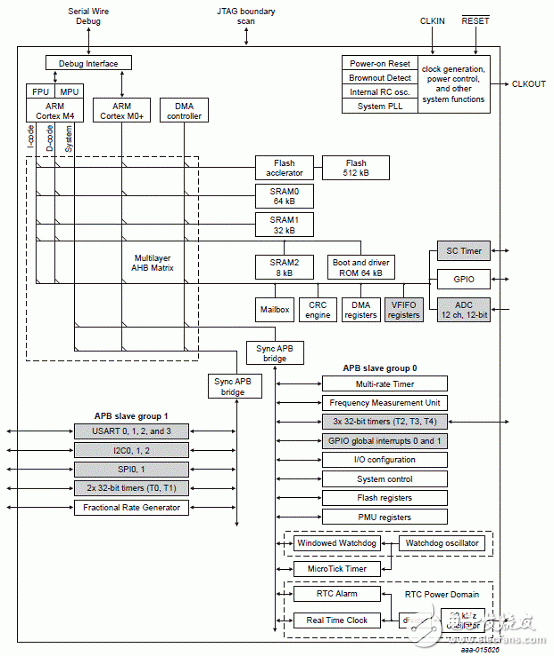
图1. LPC5410x框图
LPCXpresso54102评估板
The LPCXpresso™ family of boards provides a powerful and flexible development system for NXP’s Cortex®-M family of MCUs. They can be used with a wide range of development tools, including the NXP’s LPCXpresso IDE. The LPCXpresso54102 board has been developed by NXP to enable evaluation of and prototyping with the LPC54100 family of MCUs, and is based on the LPC54102J512BD64 version of the MCU.
The LPCXpresso54102 on-board debug probe’s flash memory is pre-programmed to support the CMSIS-DAP protocol, or can be configured for DFU boot to use the Redlink protocol (optimized for LPCXpresso IDE). Alternatively, an external debug probe such as LPC-Link2 can be used by simply connecting it to the board via the P1 connector and powering the board via the secondary usb connector. The LPCXpresso54102 board can be used with development tools from NXP partners including Atollic, Keil, IAR, Mentor Graphics and Rowley using the CMSIS-DAP protocol option. Refer to our partners for details on using their tools with the board.
LPCXpresso54102 is fully supported by the free LPCOpen Software Development Platform for NXP Microcontrollers, which provides drivers and examples in source code for rapid product development.
LPCXpresso54102评估板主要特性:
On-board high-speed USB based debug probe with CMSIS-DAP and Redlink protocol support, can debug the on-board LPC54102 or an external target
External debug probe option
Tri-color LED, target Reset, ISP & WAKE buttons for easy testing of software functionality
Expansion options based on Arduino UNO and Pmod™, plus additional expansion port pins
On-board 1.8 V and 3.3 V regulators plus external power supply option
Built-in MCU power consumption and supply voltage measurement
UART, I²C and SPI port bridging from LPC54102 target to USB via the on-board debug probe
FTDI UART connector
Fully supported by LPCXpresso Eclipse-based IDE and GNU C/C++ toolchain, available in free and Pro versions
图2. LPCXpresso54102评估板外形图
图3. LPCXpresso54102评估板主要元件布局图
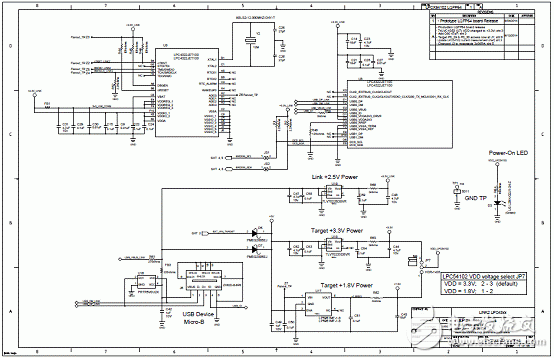
图4. LPCXpresso54102评估板电路图(1)
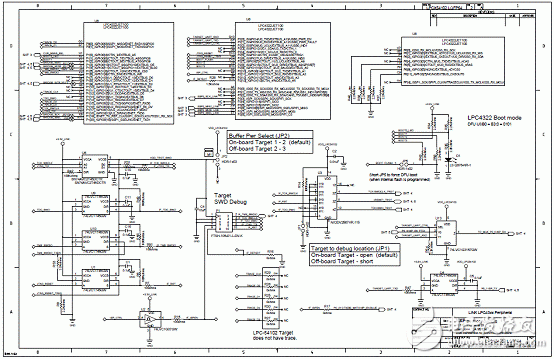
图5. LPCXpresso54102评估板电路图(2)
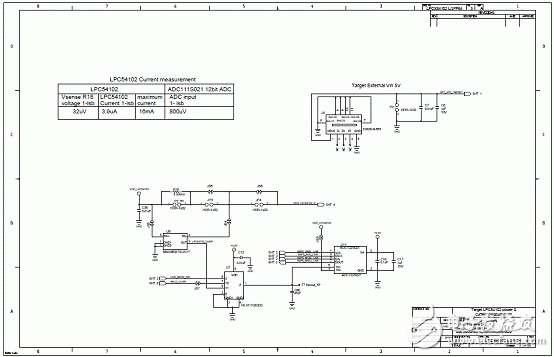
图6. LPCXpresso54102评估板电路图(3)
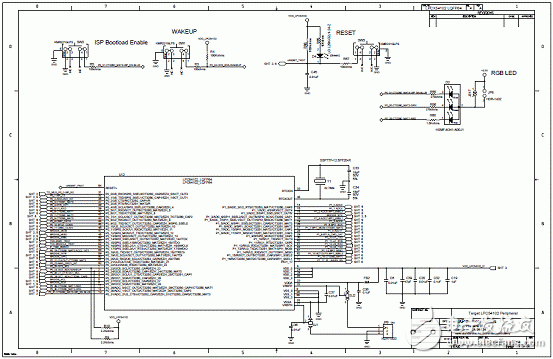
图7. LPCXpresso54102评估板电路图(4)
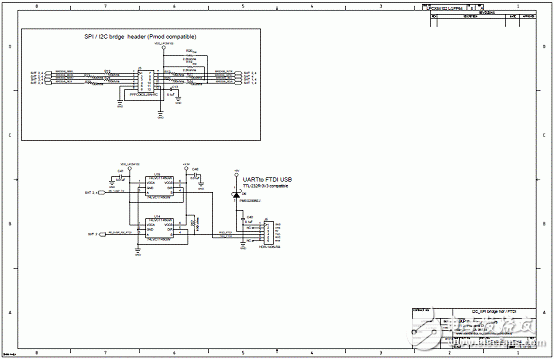
图8. LPCXpresso54102评估板电路图(5)
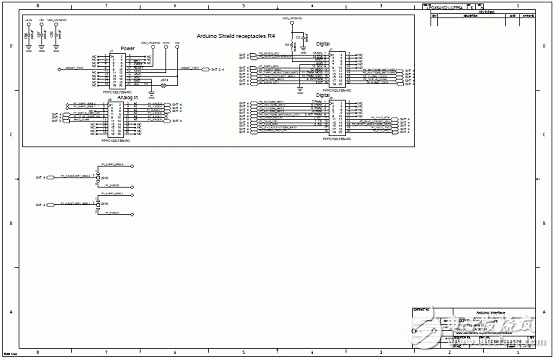
图9. LPCXpresso54102评估板电路图(6)
详情请见:
和
LPC5410X.pdf
LPCX54102_RevA_Silktop.pdf
LPCX54102_Schematic_RevA.pdf
- 相关推荐
-
世平集团推出可通过手机控制的 MiCOKit LPC5410X 开发套件2015-10-27 0
-
恩智浦NXP LPC1100L系列ARM2013-02-20 0
-
ARM CortexM0嵌入式系统开发与实践 ——基于NXP LPC1100系列2013-09-08 0
-
【NXP LPC54110试用体验】+结项2017-08-29 0
-
ARM掀32位MCU应用狂潮?NXP“求同存异”方案引人关注2009-11-19 663
-
NXP LPC2939 MCU USB接口方案2017-01-24 823
-
LPC5410x英文数据手册下载2017-08-25 828
-
NXP LPC54102传感器处理和运动解决方案2017-08-25 936
-
基于NXP LPC系列ARM IAP使用注意事项2017-10-09 950
-
基于NXP LPC21xx系列ARM芯片在ucos下启动程序分解2017-10-15 1301
-
nxp单片机汇总_lpc单片机选型2017-12-13 19108
-
[原创] NXP PC408x 32位ARM Cortex-M4 MCU开发方案2018-09-20 691
-
大联大世平推出基于NXP MCU LPC55系列电脑周边产品设计应用方案2019-07-16 1256
-
米尔科技NXP LPC1857 LPC1850 Cortex-M3开发板概述2019-11-04 4383
-
一周新品推荐:NXP的 LPC553x/S3x MCU系列和PUI Audio 的触觉反馈元件2023-11-16 822
全部0条评论

快来发表一下你的评论吧 !

